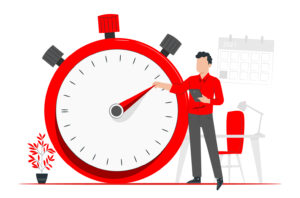Company productivity is key to staying competitive and is always a central topic in business. Productivity is measured by the ratio of an organization’s output to the inputs it uses. However, it’s important not only to track productivity but also to identify ways to improve it. This process requires defining the most significant productivity metrics that impact a company’s performance and closely monitoring performance against these metrics.
What is Productivity?
Productivity shows how efficiently a person completes a task. This concept defines the rate (output) at which a company or country produces goods and services and is usually evaluated based on the inputs (labor, capital, energy, or other resources) used to deliver these outputs.
What is Employee Performance?
Employee performance refers to the level of effectiveness, efficiency, productivity, and work quality of an individual team member within an organization. This concept encompasses how well employees fulfill their job responsibilities, the extent to which they achieve the set goals and objectives, and their contribution to the overall success of the organization.
Employee performance relies not only on quantitative metrics but also on qualitative factors such as communication skills, teamwork, problem-solving ability, and adaptability.

How to Measure Your Employee’s Performance
Employee productivity indicates how efficiently an employee works within a given timeframe. Significant factors affecting this include the work environment, employees’ physical and mental well-being, and company culture. These elements directly impact employees’ commitment and productivity.
Goals are not effective without metrics, and employees need specific indicators to track their progress. Standard metrics may include project outcomes, quality of work, efficiency, and output volume.
Set Key Performance Indicators (KPIs)
One of the greatest values of KPIs is their ability to measure business progress. These indicators are measurements you regularly track to see if your business is on track to achieve its objectives.
By tracking key performance indicators, you can monitor how close you are to achieving your strategic goals and quickly take action when things are not going as planned. Setting and monitoring KPIs allows businesses to establish an effective measurement and evaluation system toward reaching their goals. When defining and tracking KPIs, it’s essential to follow strategic steps.
Key Employee Performance Metrics
Time Management: Managing time effectively reduces stress, increases work efficiency, and enhances the likelihood of completing tasks within set deadlines. Project progress can be tracked to assess the effectiveness of time management.
Quality of Work: Regardless of the time spent, the output’s quality or compliance with company standards should be analyzed. Poor quality results that do not meet standards can negatively impact the business over time.
Teamwork: In team projects, each employee’s contribution level should be carefully measured. The ability to collaborate, work in harmony, and provide the necessary contribution to the team is essential.
Flexibility: Work processes may not always adhere to plans. The ability to quickly adapt to changes, manage stress, and maintain performance is critical.
Creativity: Large companies may have structured work processes, but the need for creative and innovative ideas is always present. In sectors where new ideas are continuously produced, such as advertising, the ability of employees to think creatively and propose innovative solutions is a sought-after criterion.
Growth: Employees who focus on professional development to increase their job efficiency add value to both themselves and the company’s objectives.
Feedback: Feedback from supervisors, team members, subordinates, or customers provides important insights into an employee’s communication skills and productivity.
Analysis and Reporting Tools
Robust analysis and reporting tools provide meaningful insights from performance data. These tools can generate customizable reports on key performance indicators (KPIs) and areas for improvement.
Individual Performance Tracking: Performance management tools detail an individual’s progress over time and performance status against set goals. These tools help track personal development processes, especially by using KPIs and SMART goals.
Team Performance Insights: Team performance data can be reported with indicators showing overall productivity trends and team KPIs. Evaluation panels are especially useful for measuring the success rate of common goals in areas like customer satisfaction and collaboration.
Feedback and Reviews: Regular feedback cycles enhance employee development and boost team cohesion. 360-degree feedback systems, which combine qualitative and quantitative assessments, help employees improve their collaboration skills.
Attendance and Absence Management: Attendance and absence data provide important insights into employee engagement and job satisfaction. High absenteeism rates may indicate potential motivation issues within the organization; hence, regular tracking of attendance rates is important.
Performance Trends: Long-term performance trends visualize general productivity declines or improvements in specific tasks. Such analyses enable strategic intervention over time.
Comparative Assessment: Benchmarking or comparative assessment allows you to analyze employee performance against internal or industry standards. This method enables strategic steps for identifying areas needing improvement and staying competitive.
Compliance and Regulatory Reporting: In fields like food safety, monitoring compliance with regulations related to performance is crucial for meeting legal requirements.
Steps to Make Performance Management Effective
Review and Optimize Your Current Processes
Start by evaluating your current performance management practices. Collect feedback from employees and managers through surveys about the current performance management system, including its effectiveness, strengths, and areas for improvement. For a more detailed look at specific issues and suggestions, conduct focus groups or one-on-one interviews. Also, assess whether employees understand how their individual goals contribute to business success.
Set Clear Goals
Define the purpose of your performance management process. For example, you might aim to increase productivity, improve employee engagement, or align individual goals with the company’s overall strategy. Once you’ve set clear goals, decide how you will measure success. Use indicators such as the number of completed projects or customer satisfaction to track improvements in employee performance.
Choose the Right Tools and Software for Your Business
Conduct thorough research to find performance management software that fits the size and needs of your business. Every business is unique, and a one-size-fits-all approach to performance management is rarely effective. Therefore, ensure that your performance management system offers adaptable features that align with your existing processes and culture.
Monitor and Evaluate Your Performance Management Process
Track the progress of your performance management: observe how employees and managers use the system, how often reviews are conducted, and whether goals are being met. Regularly ask employees for feedback about the system. Do they find it useful? Do they feel more engaged and motivated? Use surveys to collect this feedback.
Monitor the extent to which employees are achieving their goals. If you see an increase in goal achievement, this is a good indication that the system is effective and contributing to your team’s development. Compare productivity levels before and after implementing the system. Are projects being completed faster? Is work quality improving? These metrics will help you evaluate the impact of the system.
Be Open to Making Adjustments Based on What You’ve Learned
If you’re not seeing the expected impact, don’t hesitate to adjust the system. You might need to simplify some processes or increase the frequency of feedback. Such adjustments ensure that your performance management system remains effective and up-to-date.
At Perwatch, we provide the tools you need to monitor individual and team performance, gather valuable feedback, and strengthen a culture of continuous improvement. From customizable KPI reports to attendance management and productivity trend analysis, Perwatch’s performance management solutions empower you to make data-driven decisions that enhance employee engagement and productivity.
Ready to elevate your team’s productivity to the next level? Perwatch is here to support sustainable and effective performance! Learn more : https://www.perwatch.com/



